'Transferable Skills' is Jargon.
The difference between generic skills, transferable skills, and the stories that make people remember you.
Every career guide, every HR panel, every smug LinkedIn post has the same chant: Build transferable skills.
Say it enough times and it sounds like a spell, an incantation that will save you when the layoffs hit or when AI eats your job whole.
But here’s the question nobody bothers to answer: what the hell is a transferable skill?
When I left my first job as a Product Marketing Manager at Swiggy, I thought my fancy title and the fact that I helped build a new national feature would catch recruiters’ attention. It didn’t. What actually made people sit up was when I said: “I personally called the first 100 sellers and onboarded them to the platform.”
Suddenly, the questions weren’t about the feature. They were about me: How did you persuade them? How did you sell it? How did you convince people to take a bet on something new?
That was my first real lesson: your transferable skills are rarely the ones written in your job description. They’re the ones hidden in the messy, human verbs nobody notices until you name them out loud.
Most of us confuse baseline literacy with career currency. We tell ourselves:
I can type fast.
I can speak English.
I know how to use Excel.
That’s not a portfolio of transferable skills. That’s just proof you can function in a modern office. It’s the equivalent of saying, “I know how to breathe.” Useful? Yes. Differentiating? Absolutely not.
The problem with the phrase transferable skills is that it’s slippery jargon. It gets tossed into motivational speeches like confetti. And because no one defines it, most people never sit down and figure out what theirs actually are.
Which means when the world shifts (and it always shifts), they discover too late that their so-called “skills” don’t travel. They stay locked in the industry or title they came from.
That’s why I’m writing this. Not to lecture you. Not to give you another “top 10 skills” list. But to do the thing nobody bothered to do for me: break it down, gut it open, and show you how to tell the difference between I’m just competent and I’m genuinely valuable anywhere.
Because transferable skills aren’t just about employability. They’re about naming your power, about knowing what you carry with you no matter what job title or company logo you’re wearing.
And in an age where AI can write your emails, crunch your numbers, and generate passable PowerPoint decks in seconds, the only thing worth holding onto is what actually transfers.
Transferable vs. Generic (And Why You’re Probably Confusing the Two)
Not everything you can do counts as a transferable skill.
Using the internet? Generic.
Writing a polite email? Generic.
Knowing how to use Microsoft Word? Generic.
These are table stakes. The modern version of “can read and write.” Everyone’s expected to have them. They don’t make you memorable. They don’t make you valuable.
Transferable skills, on the other hand, are the ones that survive context. They work across industries, roles, and crises, and still add value. They travel well.
Think of it this way:
Generic = the screwdriver in every IKEA toolkit. Everyone’s got one. Nobody hires you for it.
Transferable = the Swiss Army knife. Compact, versatile, and still useful when the situation changes.
Here’s the litmus test:
Ask yourself: does this skill solve problems, lead people, or improve outcomes in a way that’s valuable anywhere?
If yes → transferable.
If no → probably generic.
Example: “I speak English.” Meh. Millions of people do.
But: “I can translate engineering jargon into language a CEO not only understands but actually buys into.”
Sure, AI can spit out simpler words. But persuasion is human. Getting a skeptical executive to trust you enough to make a decision, that’s a skill no algorithm can replace.
Example: “I can type 80 words a minute.” Nice.
But: “I coordinated meeting records across three departments so that no one left with different versions of the truth and prevented two near-project blowups.”
Yes, transcription software exists. But software doesn’t notice when miscommunication is about to snowball into resentment, or when a missing note will derail a deadline. That’s judgment, empathy, and anticipation. The human layer.
See the difference? One is a fact. The other is a capability with outcomes attached.
Transferable skills live in verbs and results. They live in the stories you tell about what you actually did, not the tools you used along the way.
So when someone asks you about your transferable skills, don’t answer with nouns (Excel, English, Python). Answer with verbs + outcomes: led, solved, negotiated, created, persuaded, adapted.
Employers aren’t looking for proof you exist. They’re looking for proof you matter.
Why Transferable Skills Matter More Than Ever
Time for some depressing math: according to the World Economic Forum, 44% of core job skills will change in the next five years. Nearly half of what you’re proud of today could be obsolete before your next promotion cycle.
AI can already draft your emails, crunch your data, spit out passable code, and churn design mockups in seconds. If your entire professional identity is “the person who knows this one tool really well,” congratulations, you’ve just trained a robot to replace you.
But here’s what AI still can’t do:
Convince a skeptical client.
Hold a room together when morale is tanking.
Decide which of three imperfect options is the least bad.
Navigate a screaming match between two senior stakeholders.
Sense when someone’s “I’m fine” really means “I’m drowning.”
Take accountability when things go wrong.
That’s the domain of transferable skills. They don’t get outdated with every software release. They survive chaos.
And adaptability is the meta-skill. The world right now is geopolitics in free fall, algorithms changing weekly, whole startups living or dying on one Big Tech announcement. Transferable skills aren’t just what help you survive that volatility, they’re what let you thrive in it.
I learned this firsthand. When I jumped from being a Product Marketing Manager to running a fund, it wasn’t the bullet points on my résumé that carried me across. It wasn’t “launched a feature.” It was the ability to persuade skeptical founders to trust me, to translate complex strategy into language investors understood, and to steady a team through uncertainty. Those were the skills that transferred. Not the software. Not the certificates. The verbs.
Harvard economist David Deming’s research proves the point: the jobs that grow faster and pay better are the ones that fuse technical know-how with social and problem-solving skills. Coders who can lead teams. Analysts who can persuade executives. Teachers who can reframe lessons for boardrooms.
Pure technical skill is a treadmill; you’re always racing to keep up. Transferable skills are the ladder. They compound. They don’t expire with every market shift.
Too many people worship the wrong gods: the certificate, the trendy tool, the hot new programming language. And when change comes, they realize they built their house on sand.
Transferable skills are concrete. They’re scaffolding. They’re the difference between “I was a social media manager” and “I know how to craft messages that drive action, no matter the platform.”
The world will keep moving. AI will keep learning. Industries will keep mutating. The only thing you can reliably carry into every version of the future is this: your ability to think, adapt, persuade, and connect.
If you don’t start naming and nurturing those skills now, the market will decide for you by quietly declaring you replaceable.
Sitting With Yourself (And How to Actually Identify Your Transferable Skills)
Transferable skills don’t reveal themselves in a dream. You have to drag them out. You have to sit with yourself, quietly, uncomfortably, and map the damn thing.
This isn’t about manifesting. It’s about evidence.
Grab a notebook (or a Google Doc, I don’t care). Let’s go.
1. Make a Career Timeline
Draw a line across the page. Plot your jobs, internships, side hustles, projects, even volunteer gigs. For each point, ask: what did I actually do here? Not the title. Not the job description. The verbs.
Did you persuade?
Did you mediate?
Did you fix something broken?
Did you create something from nothing?
That’s where transferable skills hide.
2. Inventory Your Verbs (But Make Them Human)
Generic résumés are tombstones: graveyards of nouns. Excel. Python. Communication. Nobody remembers nouns. People remember what you did.
Transferable skills live in verbs, the messy, human, surprising ones.
Instead of “Wrote reports” → “Translated chaos into clarity so my boss could make a decision without panicking.”
Instead of “Managed interns” → “Turned four clueless twenty-year-olds into a team that could run without me.”
Instead of “Did customer support” → “Talked a furious client down from rage-quit to renewal in 24 hours.”
Now, before you panic about cramming all this onto a one-page résumé: don’t. These stories are not for every bullet point. Prioritize verbs + outcomes on paper where you can, but save the best ones for interviews and conversations. That’s where they land hardest.
3. Ask Other People (Yes, Really)
We’re terrible at naming our own strengths. You think you’re “just organized.” Meanwhile, your colleagues think you saved the product launch because you kept ten moving parts from collapsing.
So ask:
“What do you think I’m best at?”
“When do you see me at my strongest?”
Be ready for answers that sting, or surprise you. Someone might call you “the glue,” “the strategist,” or “the firefighter.” Those are transferable labels you’d never give yourself. Write them down.
4. Distinguish Between Skills You Can Do vs. Skills You Want to Keep Doing
You may be great at crisis management because you’ve lived in chaos. That doesn’t mean you should brand yourself as a full-time firefighter.
Career coaches call these your motivated skills, the ones that energize you when you use them.
Make two lists:
Things I’m good at and want more of.
Things I’m good at but would happily never do again.
This separation keeps you from building a career around the wrong thing.
5. Group Your Clusters
Look at your scribbles. Do they cluster?
“Organizing, guiding, delegating” → Leadership.
“Analyzing, questioning, spotting inefficiencies” → Analytical problem-solving.
“Soothing, translating, persuading” → Interpersonal influence.
Transferable skills rarely stand alone. They travel in packs. Naming the cluster makes your value proposition sharper than any scattered list.
6. Find the Hidden Superpower
Sometimes the stuff you dismiss as boring is exactly where your edge hides. The trick is zooming out.
“Made travel bookings” → “Coordinated 12 moving parts across time zones, vendors, and disasters without losing my head.”
“Proofread documents” → “Caught errors no one else saw, saving the company from public embarrassment.”
“Ran errands for my boss” → “Learned to anticipate needs, read the room, and move chess pieces three steps ahead.”
“Updated spreadsheets” → “Trained myself to notice patterns and inconsistencies others glossed over.”
The reframing isn’t about inflating small things. It’s about noticing what those small things proved about you: pattern recognition, crisis management, anticipation, judgment.
If you only describe the task, you sell yourself short. But if you describe the capacity it revealed, suddenly you’re not the “assistant who ordered lunch.” You’re the strategist-in-training who already knows how to run logistics for a 200-person event.
This process is boring. It’s also brutal. But when you’re done, you won’t just have “skills.” You’ll have a map of what actually makes you useful, adaptable, and hard to replace.
That’s career currency.
The Five Buckets (And How to Reframe Your Skills So They Actually Land)
Every transferable skill you have falls into one of a few big buckets. The names sound boring- Analytical, Interpersonal, Leadership, Creative/Adaptive, Technical-lite- but the trick isn’t the category. It’s how you talk about them.
Because “good communication skills” on a résumé is white noise. But “Mediated a fight between sales and product that saved a $500K client account”? That sticks.
Let’s go bucket by bucket.
1. Analytical Skills (How You Think)
Everyone claims to be a “problem solver.” Prove it.
Bad résumé line: “Strong analytical skills.”
Better: “Identified root cause of 10% sales dip by analyzing metrics + customer feedback; sales rebounded 20% in 3 months.”
Show your process, not just the outcome. That’s what travels.
2. Interpersonal Skills (How You Deal With People)
This isn’t “I’m friendly.” It’s: can you align a messy team, resolve conflict, build trust?
Bad résumé line: “Excellent communication skills.”
Better: “Led weekly standups with five departments, improving transparency and cutting delivery time by 10%.”
Better: “Resolved 95% of customer complaints through active listening, boosting retention.”
AI can write emails. It can’t make someone feel heard.
3. Leadership Skills (How You Move People Toward a Goal)
Don’t tell me you were “team lead.” Tell me what changed under your watch.
Bad résumé line: “Managed a team of interns.”
Better: “Supervised four interns to deliver a research project two weeks early; mentored each to publish an insights report.”
Leadership isn’t a title. It’s initiative, judgment, and whether people got better because you were there.
4. Creative + Adaptive Skills (How You Survive Change)
The world is chaos. Can you pivot? Can you invent?
Bad résumé line: “Creative thinker.”
Better: “Designed and piloted a new social campaign that increased engagement 40%.”
Better: “Adapted to sudden remote-work shift by teaching myself project management software and training 12 colleagues; zero delays.”
Employers want proof you sharpen when rules change.
5. Technical-lite Skills (How You Play With Tools Without Being Scared of Them)
Not everyone has to be an engineer. But if you can learn tools quickly, you’re valuable.
Bad résumé line: “Proficient in Excel.”
Better: “Automated weekly report with macros, saving ~5 hours/week for the team.”
Better: “Implemented CRM system and trained 10 colleagues, improving customer data access.”
This isn’t about worshipping tech. It’s about showing you can harness it, adapt to it, and drag others with you.
The secret: transferable skills aren’t the categories. They’re the stories you tell inside the categories. Anyone can list “communication” or “leadership.” What makes you stand out is verbs, context, and outcomes.
Because when a recruiter skims your résumé or an interviewer hears your story, they’re not ticking boxes. They’re asking: Will this person walk into my chaos and make it better?
That’s the difference between a bullet point and a career.
How to Market Your Skills When Nobody Reads Your Résumé
Here’s the reality: résumés get skimmed by algorithms, glanced at by recruiters, and forgotten the second you leave the room.
What people remember is the story, the line they repeat to a colleague, the anecdote they share at dinner. Transferable skills don’t sell themselves. You have to perform them, narrate them, slip them into conversation like breadcrumbs.
1. Ditch the Job Title Prison
At networking events, someone asks, “What do you do?” Most people panic and mumble: “I’m a junior analyst at…” Dead air. Forgettable.
Now picture this:
“I help teams stop drowning in data by turning numbers into decisions.”
“I’m the person who makes sure deadlines don’t kill people.”
One sounds like a LinkedIn headline. The other sticks. That’s a transferable skill in action.
2. The Casual Brag (Your New Networking Currency)
Nobody wants your résumé over cocktails. But everyone loves a good story.
Instead of: “I worked in operations.”
Try: “Our delivery partner vanished 24 hours before launch. I rebuilt the logistics chain overnight on a whiteboard, and we still shipped on time.”
That’s operations. That’s crisis management. And more importantly, that’s a story people will retell.
3. Interviews = Case Studies, Not Recitals
AI can memorize the STAR method. Humans need texture.
If asked, “Tell me about a time you solved a problem,” don’t say: “I’m a problem-solver.”
Say: “Our sales pipeline flatlined. I turned detective: interviews, messy spreadsheets, shadowing reps. Found the bottleneck in delivery, rewrote the schedule, and within a quarter sales were up 15%. I felt like a forensic investigator.”
Now they see your transferable skills, analysis, perseverance, problem-solving, without you saying the words.
4. Call Out the AI Elephant
Every interviewer is secretly thinking: Why hire you when software is cheaper? Don’t wait for the question. Answer it yourself.
“Sure, AI can draft a campaign. But it can’t tell which idea will tank your reputation and which will make the board cheer. That judgment call is mine.”
“AI does the grunt work fast. But if all five AI-generated options flop, it’s not the AI on the hook, it’s you. Accountability is human. I understand deadlines, stakes, reputations. I don’t just generate options, I own the outcome.”
Position yourself as the bridge: AI is the muscle, you’re the mind.
5. Stop Claiming. Start Showing.
The least convincing line in English: “I have excellent communication skills.”
Much better: “Three departments hated a project. I got them in a room, reframed the fight as a shared goal, and we launched it on time. Now it’s our best-performing product.”
That’s communication, persuasion, and influence. No adjectives required.
6. Your Digital Footprint Is the New Résumé
Everyone stalks you: recruiters, collaborators, conference organizers. What do they see?
If your feed is just job titles and birthday posts, you’re invisible. If it’s stories, reflections, and quick breakdowns of how you solved problems, you’ve made your transferable skills searchable.
Tell enough of the right stories, and strangers will start introducing you as “the woman who untangles messy teams” before you’ve even met.
The point is simple: transferable skills aren’t sold in bullet points anymore. They’re sold in stories. People won’t remember your title. They’ll remember the launch you saved, the fight you diffused, the chaos you organized.
That’s what travels. That’s what transfers.
The Context Trap (Why Transfer Isn’t Always Equal)
Here’s the myth: if it’s “transferable,” it works everywhere.
Here’s the truth: context decides how far your skills really travel.
Take consulting. If you’re moving from Bain to BCG, your ability to synthesize a messy deck overnight or soothe cranky clients is gold. But leap into a climate startup with the same “consulting superpowers” and they may look over-polished, even shallow, unless you can also get your hands dirty. Transferable, yes. Universal, no.
Or tech. Project management in a SaaS company transfers beautifully into fintech. Try the same playbook in healthcare without learning regulatory nuance? Suddenly, your “transferable” skill hits a wall.
And sometimes the very “generic” skills people dismiss- fast typing, Excel basics- matter more than the glamorous ones. If you’re an entry-level analyst, your manager doesn’t care that you’re a visionary leader-in-waiting. They care that you can clean a dataset without crying. If you’re in frontline customer service, empathy matters, but so does answering 30 calls an hour.
Translation:
Some skills are cluster-transferable: they travel well within a sector or family of industries.
Some are scaffold-transferable: they shine only when paired with domain-specific knowledge.
And some “generic” skills are situationally non-negotiable. They won’t impress anyone on paper, but they’re the floor you can’t drop below.
This is the credibility piece. Think of it like the car salesman trick: list five amazing things about the car, then admit one drawback, suddenly the whole pitch feels believable. The same applies to your skills. If you admit they don’t transfer everywhere, people are far more likely to trust you when you say they do transfer somewhere.
The real work isn’t just naming your transferable skills. It’s knowing where they land hardest. What’s gold in one room can be wallpaper in another.
How to Research Your Transfer Patterns
Naming your transferable skills is step one. Step two is figuring out where they actually transfer. Context is king. Here’s how to map it without spinning in circles:
1. Audit Job Descriptions Across Industries
Pick 2–3 sectors you’re curious about (say, consulting → climate tech → consumer goods). Pull 10 job descriptions in each. Highlight the repeated skills. Then ask: which of these do I already do, just in a different wrapper?
Example: a teacher spots “public speaking, curriculum design, empathy” in corporate training job postings. That’s a match.
2. Trace Career Paths of People Who Jumped
LinkedIn is a cheat sheet. Look up people who’ve made the move you’re considering: banker to VC, nonprofit to sales, designer to product manager. What parts of their old life did they package up and carry over? That’s your template.
3. Look for Industry “Rosetta Stones”
Some roles are passports across sectors: project management, compliance, data analysis, and communications. If you see a function popping up in wildly different industries, that’s a strong signal your skill can travel too.
4. Read Between Recruiter Feedback
Recruiters are blunt in ways friends won’t be. If you hear, “We like your background but you don’t have XYZ,” don’t sulk; write it down. That “XYZ” is your missing adaptor. Sometimes it’s domain knowledge, sometimes it’s a technical tool. Either way, now you know the gap.
5. Test With Informational Interviews
Skip the guesswork. DM someone in your target industry: “I come from X background, my strongest skills are Y and Z. Would those be useful in your world?” Their reaction will tell you more than a thousand job boards.
6. Track Where You Get Traction
If your outreach gets ignored in one sector but sparks in another, that’s data. If your stories light up a fintech recruiter but glaze over a healthcare one, that’s a transfer signal. Reactions are market research.
The goal isn’t to imagine your skills are universal. It’s to spot the clusters where they already carry weight, and then decide: double down here, or build the missing bridge for a harder leap.
That’s the difference between a smooth pivot and a career faceplant.
The Hidden Costs of Transfer (And Why Most People Stay Put)
Here's what the Career Advice Industrial Complex™ won't tell you: Transferable skills are necessary but not sufficient. They get you in the door. They don't make you valuable on day one.
When I made the jump from product marketing to running a fund, my transferable skills - persuasion, strategic thinking, stakeholder management - absolutely mattered. But what I underestimated was how much I'd have to relearn, not just about venture capital, but about the unspoken rules, the relationship webs, the credibility signals that separate insiders from outsiders.
In product marketing, I knew which metrics mattered, which executives to loop in, how long decisions really took. In venture, I was functionally illiterate for months. I had the skills to analyze a startup, but I didn't know which questions revealed founder quality, or how to read between the lines of a pitch deck, or why some deals moved fast and others stalled.
That learning curve is real, and it's why most people stick to adjacent moves rather than complete pivots.
The Relationship Tax
Industries aren't just skill ecosystems. They're relationship ecosystems. When you switch, you're not just learning new technical knowledge - you're starting from zero on professional capital.
In product, I had built relationships over years. Partners who trusted my judgment. Clients who would take my calls. A reputation that preceded me into rooms. When you transfer industries, that social proof evaporates.
This is why "similar industry folks" often win. It's not that they're more skilled. It's that they already speak the language, know the players, understand the political dynamics. They can deliver value faster because they're not spending six months figuring out who actually makes decisions.
The Time Reality
Most career advice treats industry switches like they happen over a weekend. The reality is messier.
Surface transfer (getting hired) can happen quickly if your skills are strong. Deep transfer (becoming genuinely valuable) takes 1-3 years minimum. And full transfer (where you're as effective as you were in your old industry) can take 5+ years, if it happens at all.
That's not failure. That's just the compound nature of expertise. You can learn the basics fast, but developing judgment, building relationships, and understanding nuance takes time.
When to Make the Leap vs. When to Double Down
So when should you transfer, and when should you stay put?
Transfer when:
Your current industry is genuinely declining (not just having a bad year)
You've hit a plateau and see no path to growth
Your transferable skills are highly valued in the target industry
You're willing to take a 2-3 year hit to earning potential and seniority
Double down when:
You're still learning and growing in your current space
Your industry has long-term tailwinds
The switching costs outweigh the benefits
You can evolve your role within your current industry
The bridge strategy often works best: stay in your industry but shift functions, or keep your function but move to an adjacent industry. Consulting to corporate strategy. Marketing in tech to marketing in fintech. These moves preserve more of your accumulated capital while still offering growth.
The Bottom Line
Transferable skills are your insurance policy, not your get-rich-quick scheme. They give you options when your industry shifts. They don't guarantee immediate success in every new context.
Build them. Name them. But also be realistic about what transfer actually costs, and strategic about when to use them.
Sometimes the best career move isn't transferring your skills. It's deepening them where you are.
The Manifesto
Your job title is temporary. Your company is temporary. The software you’re fluent in today? Temporary.
The only thing you carry from room to room, crisis to crisis, industry to industry are your transferable skills.
They are the through-line. The spine. The difference between being “the person who used to work at X” and being “the person who can walk into chaos, steady the room, and deliver.”
AI will keep getting better. Industries will keep breaking. You’ll probably reinvent yourself five more times before retirement. But what endures is your judgment, your persuasion, your adaptability, your creativity, your leadership.
David Epstein calls it in Range: the Federer effect. Roger Federer played badminton, basketball, and football before tennis, and that range gave him endurance and coordination specialists lacked. Late specialization, diverse experience, transferable skillsets: they’re the edge in volatile environments.
Careers work the same way. The generalists, the bridge-builders, the people who can stitch lessons from one domain into another, they’re the ones who thrive when rules change.
Steve Jobs used to say that A players aren’t just the best at one thing, they’re the people who can move across disciplines. Designers who understand tech. Engineers who understand art. The compound skillset is what makes them irreplaceable.
So stop underselling yourself with nouns.
Stop hiding behind job titles.
Stop letting “competent” masquerade as “valuable.”
Say the verbs. Show the outcomes. Tell the stories. Build the receipts.
Because transferable skills aren’t just bullet points. They’re your resilience. They’re your leverage. They’re your career currency.
And the best part? Nobody can automate you out of them.
xo,
Harnidh.




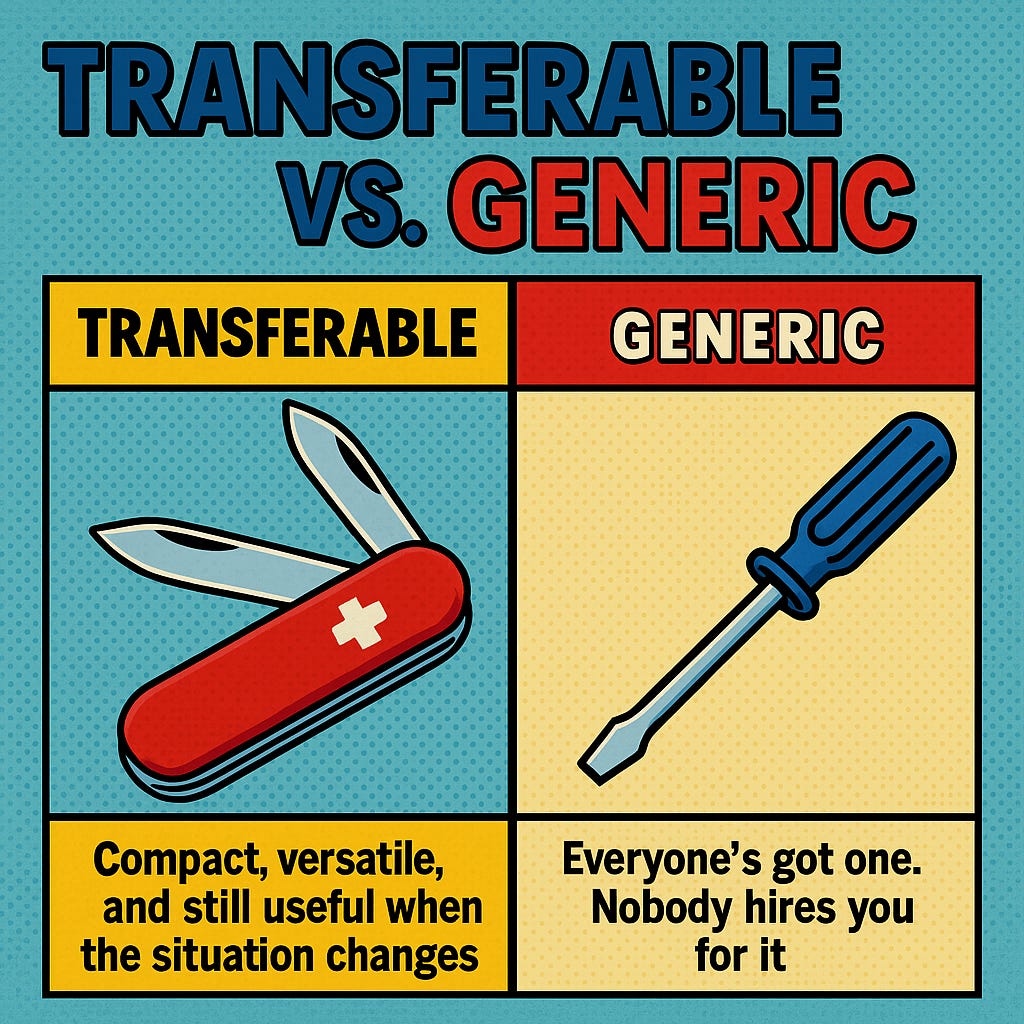
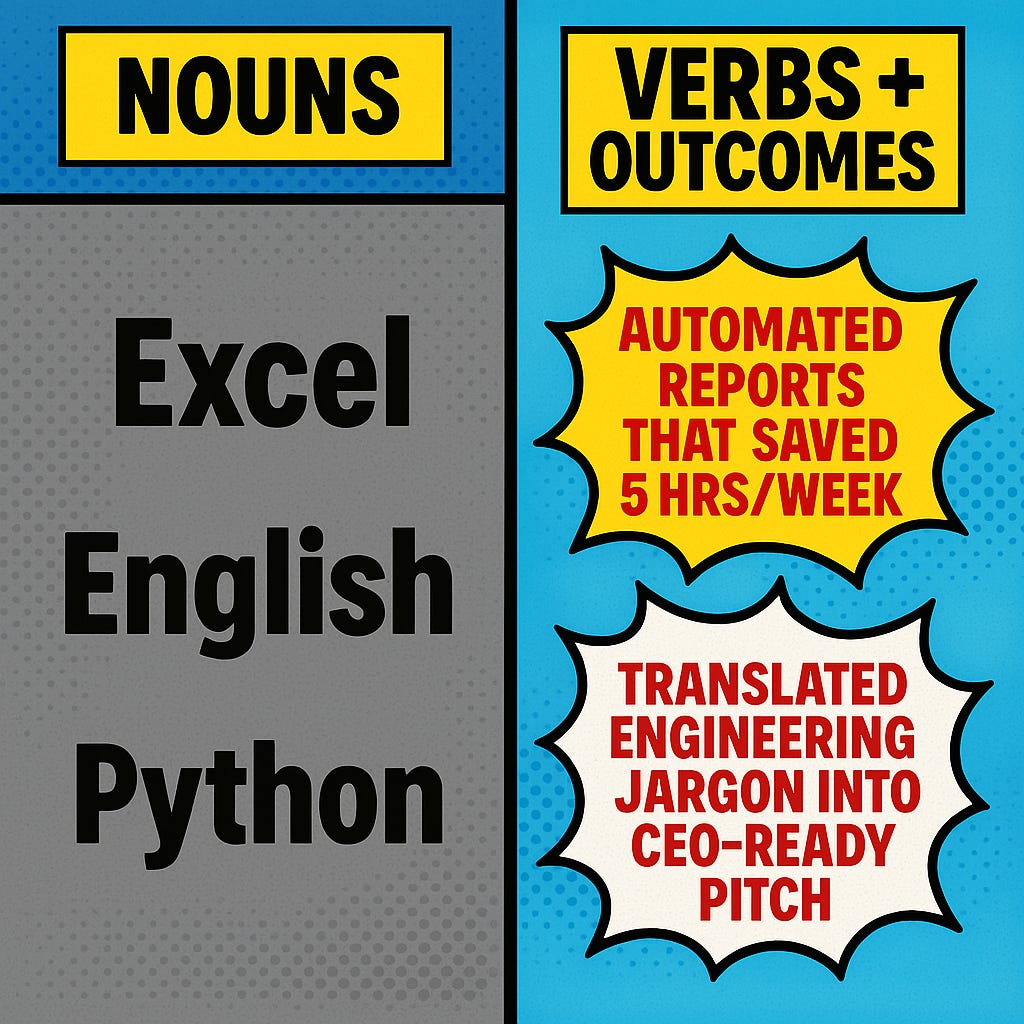

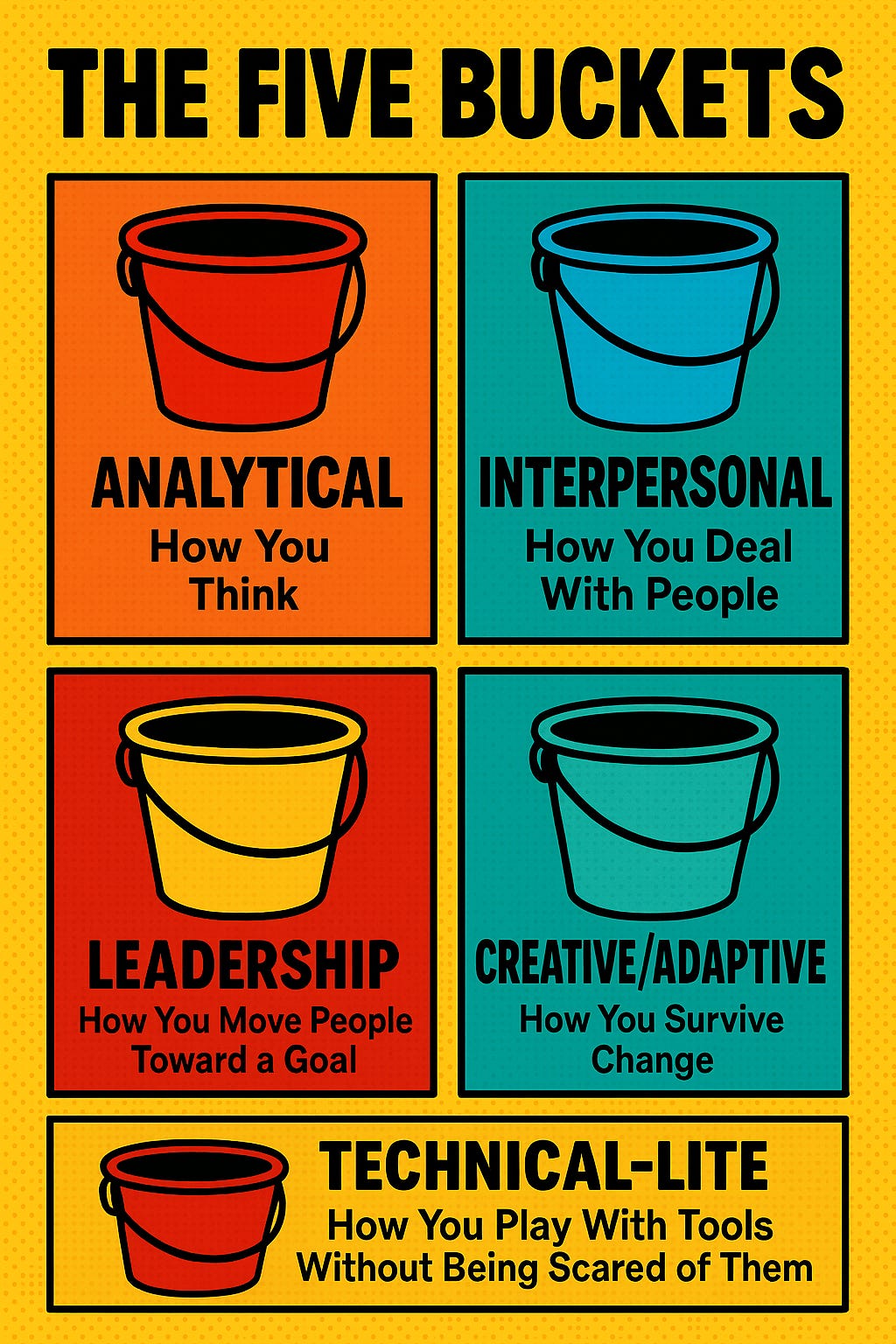
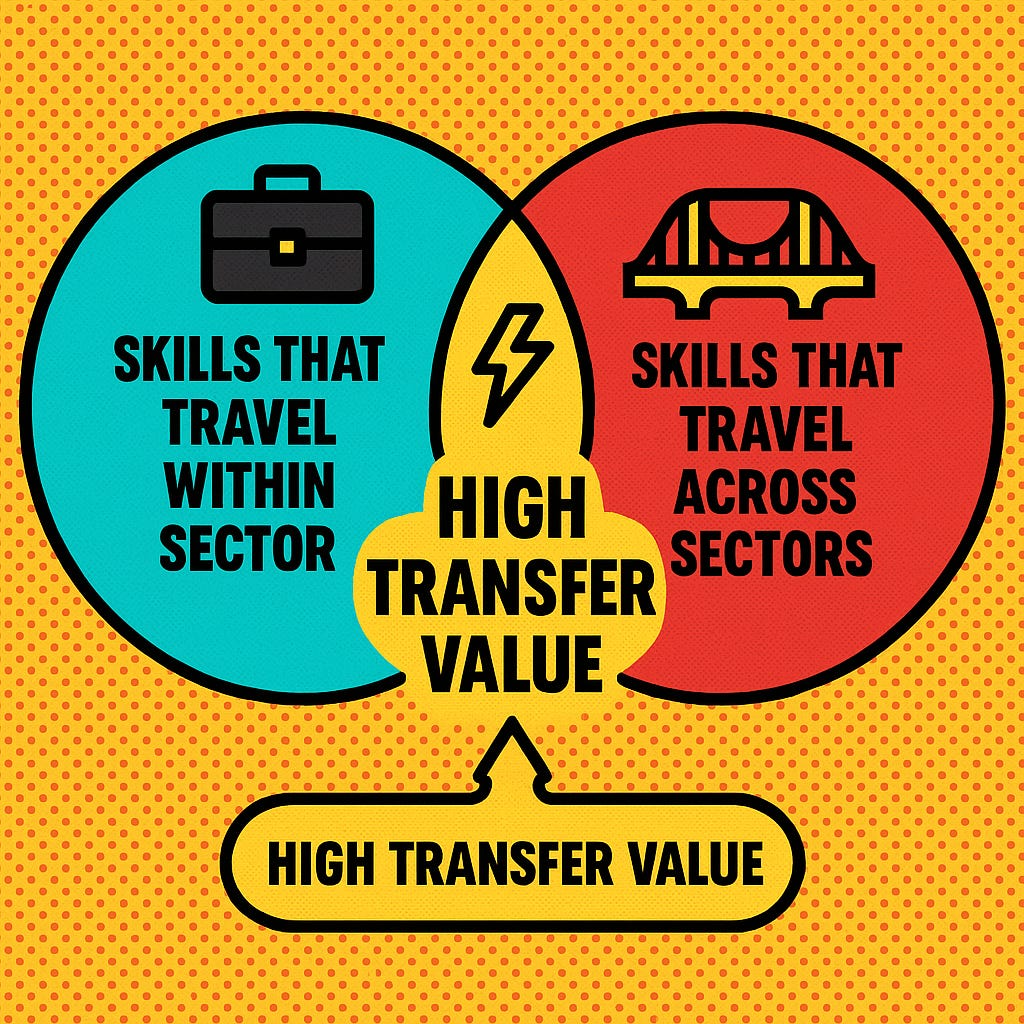
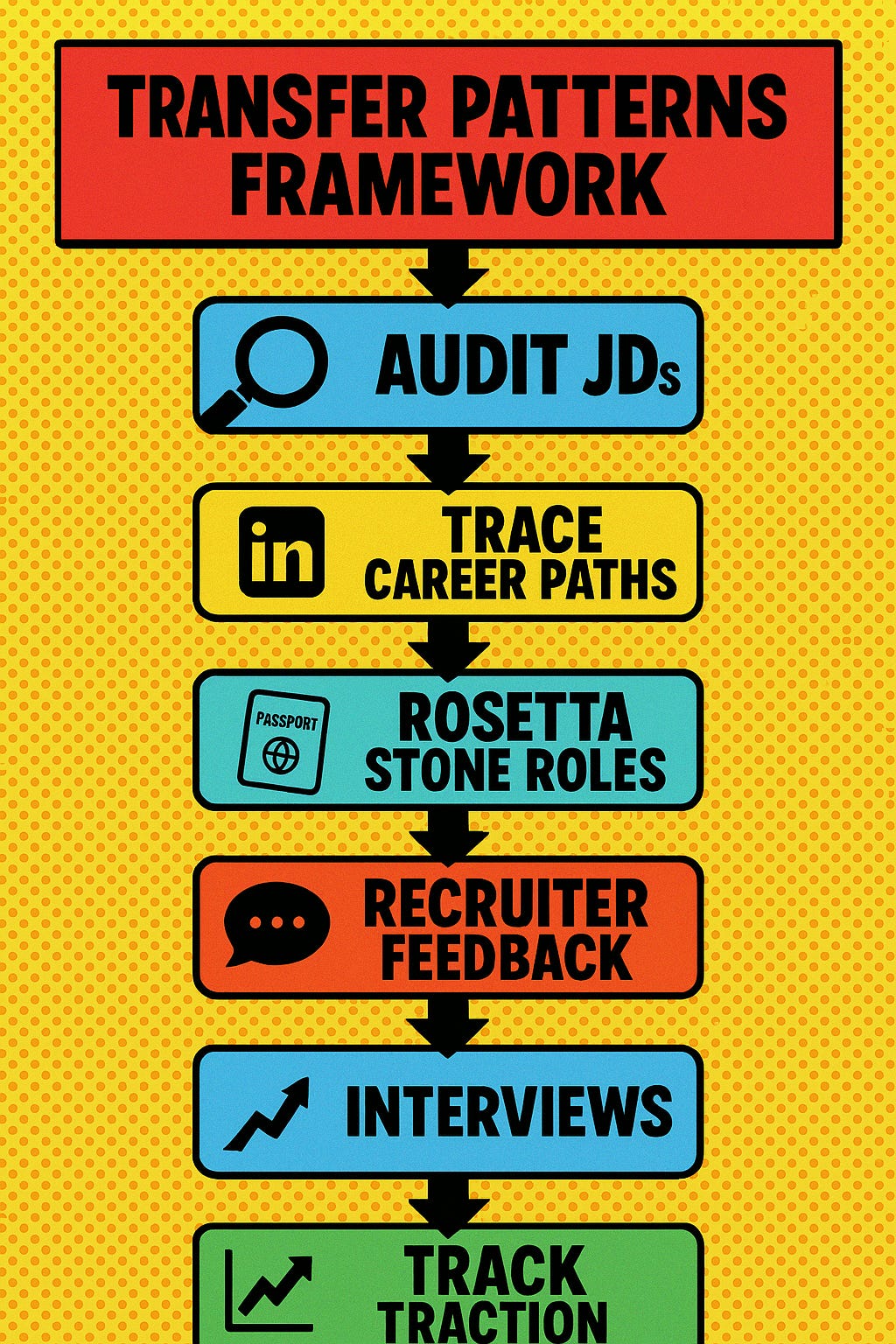

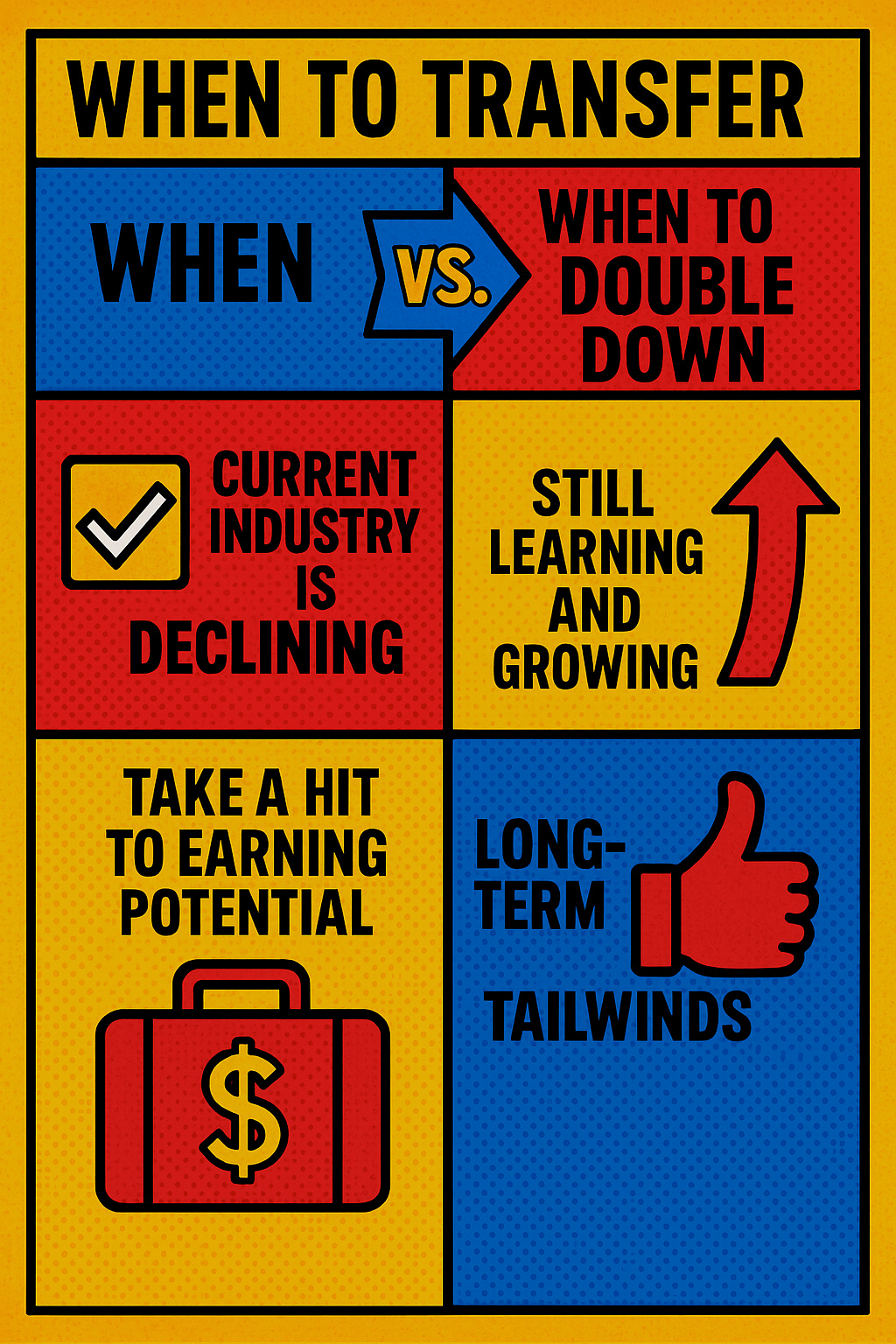
I love the examples you've used through the newsletter + it's very tightly written. Kudos! Looking forward to more :)
BRILLIANT. Absolute gold, Harnidh!